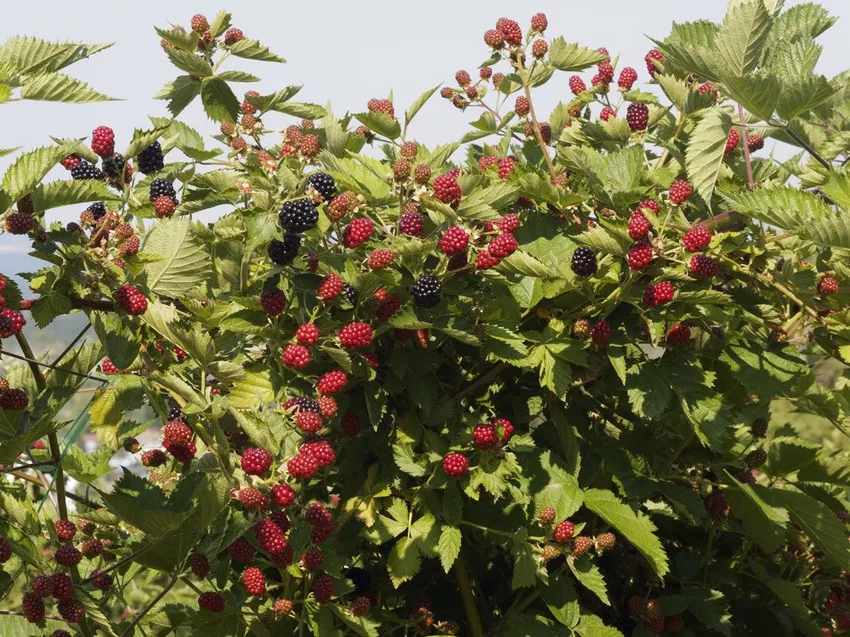Blackberries are quite hardy. Nevertheless, they can be attacked by diseases and pests. We'll tell you what to do then.
 Blackberries generally enjoy excellent he alth in open, sunny, and well-ventilated locations. Nevertheless, pests and diseases can also make things difficult for them. Pests and diseases that can occasionally threaten your berry bushes include aphids, blackberry rust and downy mildew. If an infestation occurs, you do not have to give up your berry bushes immediately. There are a number of ways you can treat the diseased plants and get them back on their feet.
Blackberries generally enjoy excellent he alth in open, sunny, and well-ventilated locations. Nevertheless, pests and diseases can also make things difficult for them. Pests and diseases that can occasionally threaten your berry bushes include aphids, blackberry rust and downy mildew. If an infestation occurs, you do not have to give up your berry bushes immediately. There are a number of ways you can treat the diseased plants and get them back on their feet.
These are the most common pests and diseases
» Aphids:
When blackberries are attacked by aphids, it leads to reduced growth of the shoots, deformation of the leaves and ultimately a reduced crop yield. If you spot the greenish pests, which can be up to seven millimeters long, on your blackberry plants, you should react immediately.
Combat:
You can take action against the plague easily and inexpensively with a self-prepared, low-concentration soap solution. Put a little washing-up liquid in ten liters of water. Fill the solution in portions into a spray bottle and spray the blackberry bushes generously. As an alternative, you can also try a treatment with tea tree oil, nettle manure or onion-lemon juice with good chances of success.
To prevent blackberries from being protected, it is advisable to plant plants such as lavender, which secrete essential oils, right next to the bushes.
» Blackberry Rust:
 In the case of blackberry rust disease, the blackberry plant is infested with a so-called rust fungus, which deprives the leaves of nutrients without completely killing them. This leads to the typical rust-red discoloration of the upper side of the leaves, while the spores can be seen on the underside of the leaves.
In the case of blackberry rust disease, the blackberry plant is infested with a so-called rust fungus, which deprives the leaves of nutrients without completely killing them. This leads to the typical rust-red discoloration of the upper side of the leaves, while the spores can be seen on the underside of the leaves.
Combat:
The disease can be easily contained if you quickly remove infested leaves and blackberry leaves lying on the ground. You can also severely cut back infested shoots and bushes that are very close togetherthin out Supplementary measures include nitrogen fertilization of the blackberries to strengthen them and treatment with organic fungicides such as COMPO Duaxo Universal Pilz-frei AF.
» Downy mildew:
The downy mildew is an egg fungus with a high damage potential. The infestation can be recognized on the upper side of the leaf by pale, yellowish discolouration, which, if left untreated, quickly turns red and then leads to the death of the leaves. In addition to the leaves, the fruits can also be affected. The fruits then turn red before ripening, dry out and, in the worst case, are covered by gray rot.
Combat:
If there is an infestation with powdery mildew, you must remove all diseased parts of the plant immediately. Densely growing shrubs should also be thinned out. If these immediate measures are not sufficient, treatment with a fungicide is necessary during post-harvest, hibernation, leaf development or bud formation. However, do not apply the fungicides between flowering and harvest.
As a preventive measure to protect against downy mildew, choosing a sunny, well-ventilated location is particularly important. Also, do not plant blackberries in the immediate vicinity of dense stands of trees. You can find more planting tips here. Proper care is also important. You can find information on this here.